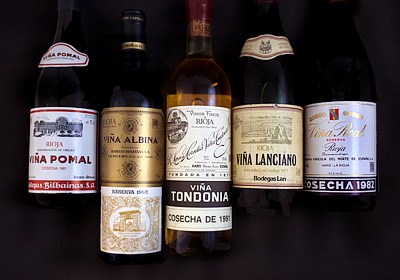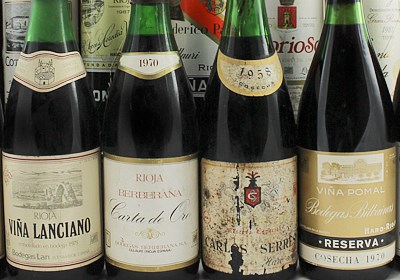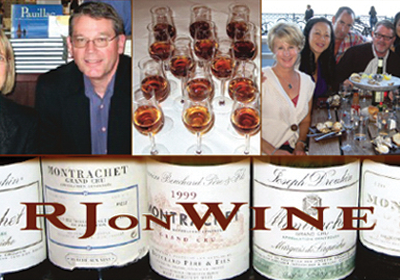
Which site would you like to visit?
By clicking the retail or wholesale site button and/or using rarewineco.com you are choosing to accept our use of cookies to provide you the best possible web experience.
Wednesday, June 1, 2011 at Contigo, San Francisco, California
On June 1st, at Contigo in San Francisco, the recent availability of some old-school Riojas made possible an evening of great Spanish food and classic bottlings that fifteen wine lovers will not soon forget.
We were treated to 14 remarkable Riojas made between 1956 and 1976, each of which demonstrated Rioja’s gift for sensual mouthfeel, reassuringly familiar bouquets of vanilla, spice and fruit, and above all, astonishing consistency. In our experience, only traditional Barolo and Barbaresco age so dependably well among red wines.
Perhaps most impressive was the wines’ consistency at all levels of perceived quality and prestige. The Riojans traditionally subscribed to a system where the most humble reds were aged just a few years in barrel and were labeled “Crianza.” Better wines were given more time in wood, at the end of which they could be called “Reserva.” And the best wines were aged up to 6 or 8 years, or even longer, in barrel before wearing the coveted designations of “Gran Reserva” or “Reserva Especial.”
We expected wines like AGE’s 1959 Fuenmayor Gran Reserva and Riojanas’ 1956 Vina Albina Gran Reserva to be breathtaking, and they were. The same could be said for Cune’s 1970 Vina Real Gran Reserva and 1976 Lopez de Heredia Bosconia Gran Reserva, which also delivered the goods.
But we were also blown away by a 41-year-old Crianza—1970 Franco-Espanolas Bordon Cosecha Especial—which, thanks to its mature, opulent, beautifully focused fruit, was among the stars of the evening. Its unlikely performance would have been like a village wine mopping the floor with grand cru heavyweights in a flight of red Burgundies.
The evening afforded a rare opportunity to experience several of the elite “pairs” for which the old-line Rioja bodegas began famous. We’re referring to the proclivity of the old bodegas to produce their top wines in pairs, with each wine put into a differently shaped bottle. Typically the wine in the slender Bordeaux-style bottle is the more elegant example, while that in the broader Burgundy-style bottle is more powerful and full-bodied. The best-known example of this practice is, of course, Lopez de Heredia’s Vina Tondonia (in the Bordeaux bottle) and Vina Bosconia (in the Burgundy bottle).
But as we experienced, Lopez de Heredia was far from alone in this practice. Of course, to this day, CUNE famously bottles its classy Imperial in a Bordeaux bottle and its Vina Real in a sloping-shouldered Burgundy bottle. But in the past, Bodegas Riojanas also made two great, classic reds—the refined Vina Albina and the more imposing Monte Real—with each in the “correctly” shaped bottle. And Bilbainas’ sleek Clarete Fino and richer Vina Pomal were bottled exactly the same way.
Here was the complete line-up (with the bottle shape in parentheses):
1956 Bodegas Riojanas Vina Albina Gran Riserva (Bordeaux)
1959 Fuenmayor Gran Riserva (Burgundy)
1964 Bilbainas Clarete Fino Gran Reserva (Bordeaux)
1964 Bilbainas Vina Pomal Reserva Especial (Burgundy)
1964 Franco-Espanolas Excelos Gran Reserva (Bordeaux)
1970 CUNE Vina Real Gran Reserva (Burgundy)
1970 Franco-Espanolas Bordon Cosecha Especial (Bordeaux)
1970 Bodegas Riojanas Monte Real Gran Reserva (Burgundy)
1973 Franco-Espanolas Royal Gran Reserva (Bordeaux)
1975 Bilbainas Vina Pomal Crianza (Burgundy)
1975 Bodegas Riojanas Vina Albina Reserva (Bordeaux)
1976 Lopez de Heredia Bosconia Gran Reserva (Burgundy)
1976 CUNE Imperial Gran Reserva (Bordeaux)
1976 Bodegas Riojanas Monte Real Reserva (Burgundy)
With the exception of the 1976 Lopez—purchased directly from the bodega two years ago—all of the wines came from restaurants or private cellars in Spain. For years, we’ve been buying old Rioja from such sources whenever we’ve had the chance, inspired by a tasting we’d attended in London in December, 1998, featuring wines from a private Madrid cellar. It was one of those wine epiphanies that changes us forever. And ever since, we've been plumbing similar collections from Spain, paying sometimes laughably low prices for 30-, 40- and 50-year-old treasures.
But such purchases soon will be impossible. With the greatness of these wines becoming more and more appreciated—and young wines rarely made in this style anymore—prices are going up at a staggering clip. Part of the problem has been that the traditional producers themselves have been forced to protect their vanishing stocks of “library wines” as demand soars. Just five years ago, we were offering 1942 Lopez de Heredia Bosconia Gran Reserva, direct from Lopez, for $325. Today, a bottle sourced from the bodega would be over $1200. And even Lopez’s 1976’s have gone from under $100 five years ago to about $300 today.
We’ve seen similar price movements at other producers, like Bodegas Riojanas and Cune. Five years ago, you could buy 1981 CUNE Vina Real Gran Reserva from us for around $50 a bottle. Today, the wholesale price in California for a bottle of this wine is $242.
Interest in these great, irreplaceable wines is just beginning to build, and it’s looking like a repeat of what has happened with traditional Barolo and Barbaresco. For now, there are still bargains to be had, but for how long?



New discoveries, rare bottles of extraordinary provenance, limited time offers delivered to your inbox weekly. Be the first to know.
Please Wait
Adding to Cart.
...Loading...


By clicking the retail or wholesale site button and/or using rarewineco.com you are choosing to accept our use of cookies to provide you the best possible web experience.

